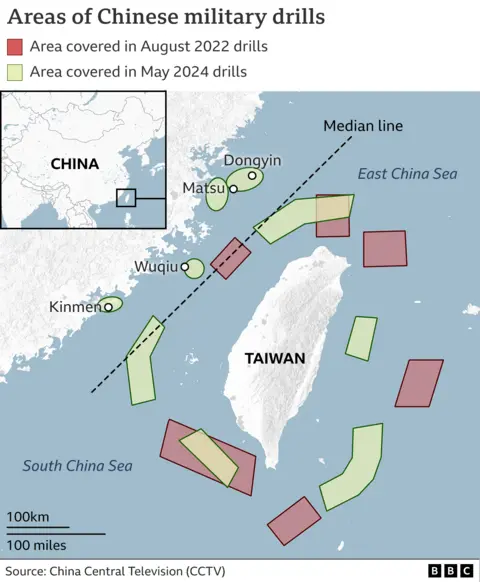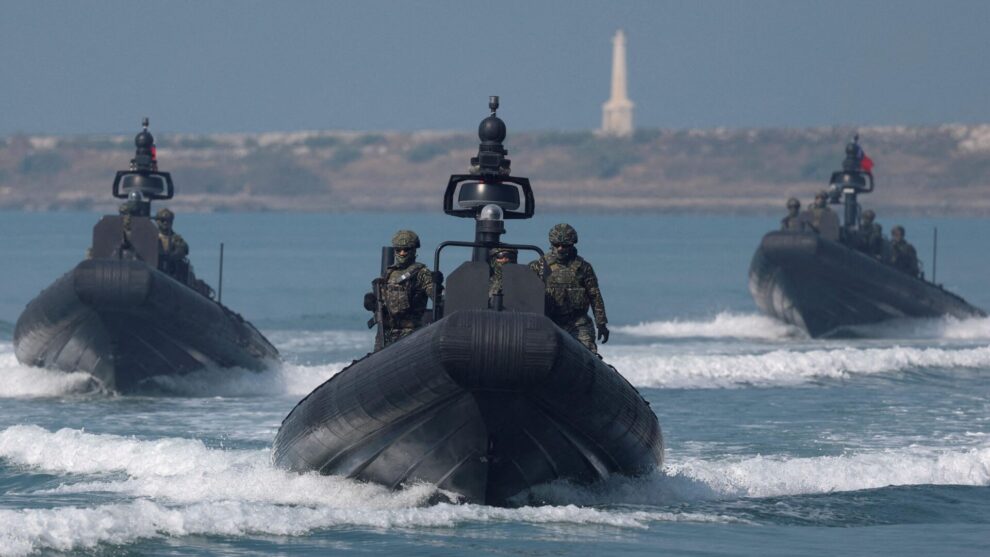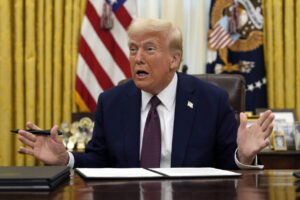China has started two days of military exercises around Taiwan, with its military calling them “strong punishment” for the self-ruled island’s “separatist acts”.
The drills come three days after the inauguration of President William Lai, who called on China to stop threatening the island and accept the existence of its democracy.
China sees Taiwan as a breakaway province that will eventually be under Beijing’s control, but the island sees itself as distinct.
Taiwan’s defence ministry condemned the Chinese drills as “irrational provocations”.
Taipei dispatched naval, air, and ground forces to “defend the [island’s] sovereignty”, its defence ministry said.
Thursday’s drills for the first time simulated a full-scale attack, Taiwanese military experts said, rather than an economic blockade.
The exercises took place all around the main island, and for the first time also targeted the Taipei-controlled islands of Kinmen, Matsu, Wuqiu and Dongyin which lie close to the Chinese coast, according to maps released by China’s People’s Liberation Army (PLA).
Drills show China really doesn’t like Taiwan’s new president
The drills also included a component to the east of Taiwan – the island’s rugged east coast on the other side of a mountain range has long been its military redoubt.
Taiwan has built much of its hardened military infrastructure along this coast, including a large underground airbase inside a mountain near the city of Hualien. It is also close to Japan’s southern islands, and a natural resupply route.
By sending naval and air patrols to the east of Taiwan, China aims to show Taipei that its east is now exposed to Chinese attack, and to show the Americans that any effort to resupply or re-enforce Taiwan from the east is vulnerable to Chinese missile strikes and naval attack.
The PLA said its drills focused on joint sea-air combat-readiness patrols, precision strikes on key targets, and integrated operations inside and outside the island to test the “joint real combat capabilities” of its forces.
Taiwanese media cited military expert Chieh Chung saying the ongoing exercise is aimed at “simulating a full-scale armed invasion of Taiwan”.

China has repeatedly rehearsed encircling Taiwan with fighter jets and navy ships over the past year. Taipei had reported an uptick in incursions into Taiwanese waters and airspace in the run-up to Mr Lai’s inauguration.
China carried out its first “encirclement” operation in August 2022, following a historic visit by then US House Speaker Nancy Pelosi, simulating a blockade of the main island of Taiwan with ships, aircraft and missile strikes.
The PLA said Thursday’s drills were a “strong punishment for the separatist acts of Taiwan independence forces and a stern warning against the interference and provocation by external forces.”
Meanwhile China’s foreign ministry insisted the drills were a “necessary and legitimate move” to safeguard national sovereignty.
“I need to stress that Taiwan is an inalienable part of China’s territory. This is both a fact based on history and the true status quo. This will not change in the future. Taiwan independence is doomed to fail,” spokesman Wang Wenbin said.
In his inauguration address last Monday, Mr Lai called on China to “stop threatening Taiwan”.
Beijing denounced the speech, with Foreign Minister Wang Yi describing Mr Lai as “disgraceful”.
After Mr Lai’s election victory last January, Beijing issued a statement insisting that “Taiwan is part of China”. It has also repeatedly rebuffed Mr Lai’s offers for talks.
Beijing has previously labelled Mr Lai a “separatist” and “troublemaker” over remarks he made in the past supporting Taiwanese independence.
Taiwan’s defence ministry said the drills on Thursday “highlight [Beijing’s] militaristic mentality”.
“In recent years, the continuous harassment by Chinese aircraft and ships has significantly harmed global peace and stability,” it said.
Taiwan’s presidential office has said it was “regrettable” to see China “using unilateral military provocations to threaten Taiwan’s democracy and freedom”.
Meanwhile Taiwan’s Mainland Affairs Council – which oversees relations with China – said Taiwan’s aim of maintaining cross-strait peace has not changed.
“Beijing should understand that its intimidating tactics will not win hearts and minds,” said spokesman Liang Wen-chieh.
While China and Taiwan remain trading partners, they no longer have a formal channel of communication and much of the world offers diplomatic recognition to China, but not Taiwan.
Analysts say Bejing’s claims have become far louder and unyielding under Xi Jinping, who has repeatedly stressed that “reunification” will happen – most recently in December, weeks before Taiwan’s election.
So far, China’s military manoeuvres around Taiwan have fallen short of an invasion and stayed within a grey zone.
Analysts have told the BBC that grey zone warfare tactics are aimed at weakening an adversary over a prolonged period – and say that is exactly what China is trying to do with Taiwan.
China and Taiwan – the basics
- Why do China and Taiwan have poor relations? China sees the self-ruled island as a part of its territory and insists it should be unified with the mainland, by force if necessary. Taiwan sees itself as distinct
- How is Taiwan governed? The island has its own constitution, democratically elected leaders, and about 300,000 active troops in its armed forces
- Who recognises Taiwan? Only a few countries recognise Taiwan. Most recognise the Chinese government in Beijing instead. The US has no official ties with Taiwan but does have a law which requires it to provide the island with the means to defend itself
Source: BBC










